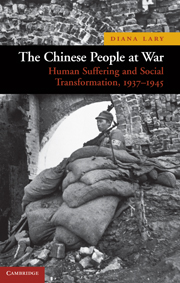Book contents
- Frontmatter
- Contents
- List of Illustrations
- List of Maps
- Preface
- Introduction: The Human Cost of War
- 1 The High Tide of War: July–December 1937
- 2 Defeat and Retreat: 1938
- 3 Stalemate and Transformation: 1939–1941
- 4 Grim Years: 1942–1944
- 5 Turning Points: 1944–1945
- 6 The Immediate Aftermath of the War: 1945–1946
- 7 The Legacy of the War
- Final Words
- Glossary
- Index
- References
6 - The Immediate Aftermath of the War: 1945–1946
Published online by Cambridge University Press: 05 June 2012
- Frontmatter
- Contents
- List of Illustrations
- List of Maps
- Preface
- Introduction: The Human Cost of War
- 1 The High Tide of War: July–December 1937
- 2 Defeat and Retreat: 1938
- 3 Stalemate and Transformation: 1939–1941
- 4 Grim Years: 1942–1944
- 5 Turning Points: 1944–1945
- 6 The Immediate Aftermath of the War: 1945–1946
- 7 The Legacy of the War
- Final Words
- Glossary
- Index
- References
Summary
Wandering between two worlds
One dead, the other powerless to be born
Events
The end of the eight-year Resistance War came on the same day that the Pacific War ended, August 15, 1945, the day Japan announced her unconditional surrender. The events that precipitated the end of the war took place not in China, but in Japan, where the dropping of the second atomic bomb on Nagasaki forced the Japanese government to surrender. The end of the war was sudden, but the process of surrender of Japanese forces that followed was painfully slow.
The formal surrender of Japanese forces in China took place in Nanjing, at 9 a.m., on September 9 – 9.9.9. Another ceremony was held in Beiping on October 10 – the thirty-fourth anniversary of the Wuchang Rising that precipitated the 1911 Revolution. Japanese troops were ordered to surrender only to Guomindang (GMD) forces, not to Chinese Communist Party (CCP) forces. Little by little, GMD forces took over places that had been occupied. They were not always the liberators local people had expected [Reading 1]. The surrenders were long and drawn out. In Xiamen, GMD troops did not arrive to take surrender until October 3. Japanese troops stayed on at their posts until they could surrender to the GMD, in the last cases not until early 1946. In Hong Kong, to the surprise of many Chinese inhabitants, Chinese troops did not arrive at all; the British resumed control in September.
- Type
- Chapter
- Information
- The Chinese People at WarHuman Suffering and Social Transformation, 1937–1945, pp. 169 - 193Publisher: Cambridge University PressPrint publication year: 2010



